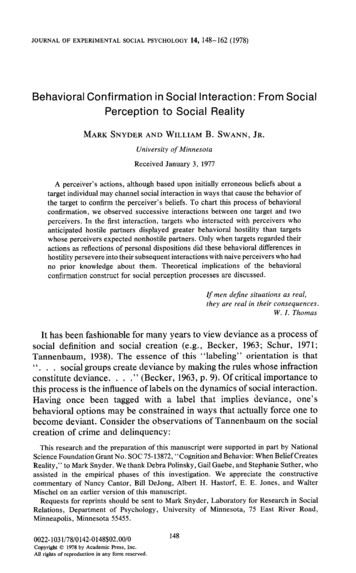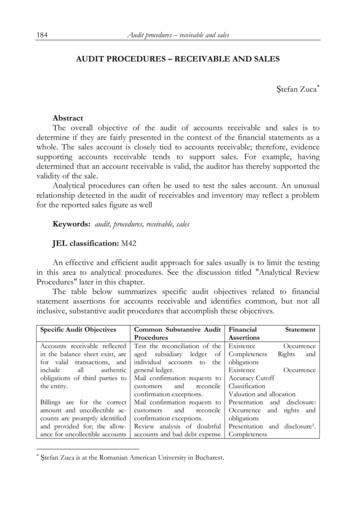
Transcription
IOURNALOF EXPERIMENTALBehavioralSOCIALPSYCHOLOGY14, 148-162 (1978)Confirmationin Social Interaction:Perceptionto Social RealityFrom SocialMARK SNYDER AND WILLIAM B. SWANN, JR.Universityof MinnesotaReceived January 3, 1977A perceiver’s actions, although based upon initially erroneous beliefs about atarget individual may channel social interaction in ways that cause the behavior ofthe target to confirm the perceiver’s beliefs. To chart this process of behavioralconfirmation, we observed successive interactions between one target and twoperceivers. In the first interaction, targets who interacted with perceivers whoanticipated hostile partners displayed greater behavioral hostility than targetswhose perceivers expected nonhostile partners. Only when targets regarded theiractions as reflections of personal dispositions did these behavioral differences inhostility persevere into their subsequent interactions with naive perceivers who hadno prior knowledge about them. Theoretical implications of the behavioralconfirmation construct for social perception processes are discussed.If men define situationsas real,they are real in their consequences.W. I. ThomasIt has been fashionable for many years to view deviance as a process ofsocial definition and social creation (e.g., Becker, 1963; Schur, 1971;Tannenbaum,1938). The essence of this “labeling”orientation is that“ . . . social groups create deviance by making the rules whose infractionconstitute deviance. . . .” (Becker, 1963, p. 9). Of critical importance tothis process is the influence of labels on the dynamics of social interaction.Having once been tagged with a label that implies deviance, one’sbehavioral options may be constrained in ways that actually force one tobecome deviant. Consider the observations of Tannenbaum on the socialcreation of crime and delinquency:This research and the preparation of this manuscript were supported in part by NationalScience Foundation Grant No. SOC 75-13872, “Cognition and Behavior: When Belief CreatesReality,” to Mark Snyder. We thank Debra Polinsky, Gail Gaebe, and Stephanie Suther, whoassisted in the empirical phases of this investigation. We appreciate the constructivecommentary of Nancy Cantor, Bill DeJong, Albert H. Hastorf, E. E. Jones, and WalterMischel on an earlier version of this manuscript.Requests for reprints should be sent to Mark Snyder, Laboratory for Research in SocialRelations, Department of Psychology, University of Minnesota, 75 East River Road,Minneapolis, Minnesota 55455.0022-1031/78/0142-0148 02.00/OCopyrightAU rights0 1978 by Academic Press, Inc.of reproductionin any form reserved.14s
BEHAVIORALCONFIRMATION149The process . . becomes a way of stimulating . . and evoking the verytraits that are complained of. . . The person becomes the thing he is describedThe community expects him to live up to his [deviant] reputation,as being. .and will not credit him if he does not live up to it (Tannenbaum, 1938, pp. 19-20;477).Similar themes emerge from descriptions of the effects of stigmatization(e.g., Goffman, 1963; Scott, 1969; Szasz, 1961). Most notably, Goffman(1963) has argued that we may unintentionally“force” the stigmatized toplay the roles we prescribe for them. Stigmatized individuals may thus fall“victim”to cultural stereotypes and expectations. Ex-mental patients orformer prisoners may be provoked by the prejudicial treatment of othersinto angry reactions that may then be interpreted as manifestations of theirdisturbance, and in turn justify treating them as socially dangerousdeviants.The case histories and descriptive prose of the labeling theorists sensitizeus to the possible impact of labels on subsequent social interaction.However, within social psychology, this concern with the interpersonalconsequences of social perception has been largely neglected. Researchersand theorists concerned with social perception and attribution processeshave focused their attention on the information-processing“machinery”by which individualsattempt to understand an actor’s behavior (e-g.?Jones, Kanouse, Kelley, Nisbett, Valins, & Wiener, 1972). Conspicuouslyneglected within this cognitive social psychology is a consideration of theeffects of interpersonalperceptions (including social labels) on socialinteraction. It is this reality-constructingfunction of social perception withwhich we are concerned. Accordingly,we ask: Can a perceiver’sperceptions of another individual channel social interaction in ways thatactually cause the target individual’sactions to provide behavioralconfirmationof the perceiver’s beliefs? The descriptions of the labelingtheorists tentativelysuggest an affirmative answer. So too does theresearch literature of empirical social psychology.In certain specific contexts, a perceiver’s expectations may influenceanother individual’sbehavior (e.g., Jones & Panitch, 1971; KelleyStahelski, 1970: Kuhlman & Wimberley,1976; Miller & Holmes, 1Rosenthal, 1974). Thus, Rosenthal and his colleagues have documentedways in which teachers and experimenters who expect particular patternsof performance from their students and subjects actually can and do elicitperformances that confirm these expectations (for a review, see Rosenthal,1974). As impressive as these demonstrations are, certain constraints ofthesituations studied may have produced a process quite different from thehypothesizedbehavioral confirmationprocess, Interactionsbetween“trainers” (teachers and experimenters) and “performers”(students andsubjects) are highly structured and focused on selected criterion behaviors(the dependent variable in the psychologicalexperiment,academic
1.50SNYDERANDSWANNperformance in the classroom). Expectancies are generally explicitlycommunicated to the trainers and usually have high credibility. Teachersand experimenters may feel that their own competence is being put to test.TO the extent that their students and subjects behave as expected, theircompetence as teachers and experimenters is confirmed in both their owneyes and the eyes of the source of the expectancies. Indeed, in studies ofexperimenter effects, experimenters often are told that the purpose oftheirparticipationis to see how well they can replicate well-establishedexperimental studies (e.g., Rosenthal & Fode, 1963). Thus, teachers andexperimentersmay be acting to validate or bolster their own selfconceptions of competence and efficacy (cf. Secord & Backman’s, 1965,analysis of response-evocationas one means of maintainingselfperceptions).However, research in other contexts does suggest that actions based oninterpersonal perceptions may produce behavioral confirmation. Correlational analyses by Kelley and Stahelski (1970) indicate that individuals withcompetitive orientations to social relationships believe the world to becomposed homogeneously of competitive individuals. By contrast, thosewith cooperative orientations construe the world to be more heterogeneously composed of both competitiveand cooperativepeople. Oneconsequence of these stereotypes is that competitive individuals are highlylikely to elicit competitive responses from their partners in the Prisoner’sDilemma situation, whether these partners have cooperative or competitive dispositions. Thus, the feedback that competitors receive validatestheir stereotype that all people are competitive,even though it was theirown behavior that determined their partner’s competitivebehavior.However, this effect may be specific to the structural characteristics of theparticular Prisoner’s Dilemma situation used by Kelley and Stahelski(Miller & Holmes,1975). To this extent, this and other laboratoryinvestigations of the interpersonal consequences of social perception thathave relied on the Prisoner’s Dilemma game (e.g., Jones & Panitch, 1971;Kuhlman & Wimberley,1976) may be of limited relevance to behavioralconfirmation processes.Despite the interpretiveambiguitiesassociated with some of theprocedures and results reviewed above, this evidence seems to indicatethat perceivers’ initial beliefs about another (target) individual may leadthem to channel their subsequent interaction with this individual in waysthat cause the target’s behavior to confirm these beliefs. But how stable andenduring are the effects of this behavioral confirmationprocess? Ifbehavioral confirmationwere limited to the confines of the specificinteraction between perceiver and target, it would be an inconsequentialeffect of interpersonal perception.If the “new” behaviors displayed by the target are not overly discrepantfrom his or her own self-image, these new behaviors may be internalized.
BEHAVIORALCONFIRMATION151The “latitudeof acceptance” for internalizationor accommodationofself-perceptionsto new behaviors may be rather wide (cf. Secord &Backman, 1965). Most people believe that they possess a wide variety oftraits; witness their readiness to accept bogus personality descriptions indemonstrationsof the P. T. Barnum effect (e.g., Meehl, 1956; Stagner,19.58; Ulrich, Stachnik, & Stainton, 1963). Moreover, most people believethat they often express apparently contradictorytraits in differentsituations (Nisbett, Caputo, Legant & Marecek, 1973). Accordingly,awide variety of perceivers’ beliefs may be made to “stick”as aconsequence of behavioral confirmation processes.If the target’s new behaviors generated by the behavioral confirmationprocess are internalized, then both the target and the perceiver will shareperceptions of the target. What began in the mind of the perceiver will havebecome reality not only in the behavior of the target but also in the mind ofthe target. The target may then be prepared to act on this newself-perception in the contexts beyond those that include the originalperceiver. Then the target may provide other perceivers with behavioralevidence consistent with the original perceiver’s expectations and thesenew perceivers will treat the target accordingly.Contemporary attribution theories (e.g., Jones et al., 1972) suggest thatthe internalizationand perseveration of behavior are most likely to occurwhen targets accept their new behaviors as representativeof theirunderlying personality traits (that is, when targets make dispositionalself-attributions).By contrast, when targets attribute their new behavior tothe specific influences of the perceiver and the context of their interaction(that is, make situational self-attributions),behavioral confirmation will belimited to interactions with that perceiver.To investigate the process of behavioral confirmation and its perseveration over situations, we conducted an experiment in which one maleparticipant (the “target”)interacted on successive occasions with twoother male participants(the “labelingperceiver”and the ““naiveperceiver”)in a context designed to permit assessment of behavioraimanifestationsof hostility. Prior to the first interaction,the labelingperceiver was given access to information that led him to believe the targetto be a hostile individual(Hostile Label condition) or a nonhostileindividual(NonhostileLabel condition).This first interactionwasstructured SO as to induce the target to regard his actions either asrepresentativeof correspondingpersonal dispositions(DispositionalAttribution condition) or as a reflection of transitory influences ofthe otherparticipant’s behavior (Situational Attributioncondition). In the secondinteraction, the target interacted with a naive perceiver who had no priorexpectations about the target’s dispositions and no knowledge of his priorhistory. We expected that:(1) In the first interaction, between the labeling perceiver and the target,
152SNYDER AND SWANNthe labeling perceiver’s beliefs would receive behavioral confirmation:Targets believed to be hostile would actually come to display morebehavioral manifestationsof hostility than would targets regarded asnonhostile.(2) Behavioral confirmation would persevere into the second interaction, between the naive perceiver and the target, only under DispositionalAttribution conditions: Those targets who had originally been labeled ashostile would continue to manifest more behavioral hostility than wouldthose targets who had been labeled as nonhostile.We first present our empirical demonstration of behavioral confirmationin social interaction, and then outline a theoretical account of the processesthat we believe to underlie behavioral confirmation.METHODParticipantsOne hundred and eight male undergraduates at the University of Minnesota participated inthis experiment for extra credit in their introductory psychology course. Groups of threepreviously unacquainted participants were scheduled to report to separate waiting rooms.Each participant was randomly assigned to one ofthree “roles”: labeling perceiver, target, ornaive perceiver.The First Interaction:LabelingPerceiverand TargetThe experimenter escorted the labeling perceiver and the target to adjacent experimentalrooms, leaving the naive perceiver in his waiting room. Each room was equipped withheadphones, a telegraph key, and a signaling system that fed into a control room. Beforelearning about the experimental tasks, the labeling perceiver and the target each completed a“Trait Survey” questionnaire that consisted of 15 self-descriptive items. Five of these itemsset the stage for the soon-to-be-enactedlabel -assertive, kind-unkind, passive-aggressive, cooperative-competitive.The experimenter then explained separately to each participant that he would compete in areaction time task with an opponent in the next room. The competition was to consist of 24trials grouped into eight blocks, each with three trials. On each trial, both players wouldrespond as quickly as possible to a signal. The player with the faster reaction time would be thewinner. Each player’s wins and losses would be determined not only by his speed, but also byhis clever and strategic use ofa “noise weapon.” The availability of this noise weapon was toalternate, block by block, between the players. At the onset ofeach block, the user ofthe noiseweapon could adjust it to deliver one of six intensities of noise to his opponent for the durationof that block. A “1” level noise was generally regarded as inoffensive, a “3” level noise wastypically perceived as distracting, and a “6” level noise was almost uniformly felt asoffensively irritating and annoying, but not physically painful. Each player then experiencedthe relative intensity of each noise level. Use of the noise weapon constituted our dependentmeasure of the extent of behavioral hostility displayed by each participant.The attribution manipulation-Partone. The first part of the attribution manipulationchanneled the perspective that the targets would use in observing, encoding, and interpretingtheir behavior during the ongoing interaction (cf. the successful use of observational sets toinfluence attributional processes, e.g., Regan & Totten, 1975; Taylor & Fiske, 1975). Toencourage targets in the Dispositional Attribution conditions to regard their noise weapon
BEHAVIORALCONFIRMATION153usage as a reflection oftheir own personal characteristics and individual reactions to the task,the instructions stressed these points: (a) Previous research bad indicated that “the loudnessof the noise bursts most people choose to deliver to their opponent depends on the tYPe ofperson they are and what they think is the best way of winning competitive reaction time taskslike this one”; (b) typically, a person performs best “if he uses the strategy that uniquely fitshis capabilities and personality;” and (c) in planning his strategy, he should ask himselfseveral questions, including: “Am I the kind of person who likes to use a competitive orcooperative strategy in situations like this?”To encourage targets in the SituationalAttributionconditions to construe their use of thenoise weapon as a reaction to their opponent’s treatment of them, the instructions stressedthese points: (a) Previous research had indicated that “the loudness of the noise bursts mostpeople choose to deliver to their opponent depends on how their opponent uses his noiseweapon against them”; (b) typically, people perform best when they “devise their strategy bytaking into account the strategy that their opponent has used and might use in the future”: and(c) in planning his strategy he should ask himself several questions, including: “Is myopponent the kind of person who will try to slow down my reaction time QTintimidate me bydelivering very loud noise bursts to me?“.The /abef manipulation.After hearing a description of the reaction time task, each /abeiingperceiverlearned that, in order to help him plan his strategy, he would have access to hisopponent’s “Trait Survey” questionnaire. He received one of two qnestionnaires, preparedin advance, to induce him to view his opponent either as a hostile individual or as a nonhostileindividual. Labeling perceivers who had been randomly assigned to the Hostiie &be!conditions learned that they were pitted against an opponent who loved contact sports andwho described himself as relatively insensitive, self-assertive, cruel. aggressive, andcompetitive. By contrast, labeling perceivers in the NonhostileLabel conditions discoveredthat their opponents enjoyed writing poetry and sailing and thought of themselves as rathersubmissive, sensitive, passive, kind, and cooperative types.Competitionand use ofthe noise weapon.The experimenter then signaled both participantsto put on their headphones for the first trial of the competition. He signaled the labelingperceiver to set his noise weapon for the first block of three trials.Each trial consisted of four discrete events: (I) A noise weapon tone of the designatedintensity was sounded in the headphones of either the target or the labeling perceiver; (2) the“ready light” flashed, telling both players to depress the telegraph key: (3) the release lightflashed, signaling players to release the key as quickly as possible; and (4) the noise weapontone was turned off. After each block of three trials, the noise weapon changed bands.After the 24 trials, the labeling perceiver was escorted ont of the experimental room andasked to record his final impressions of his opponent. The experimenter then invited the targetto play a new opponent in a second session. He did not provide the target with any explicitfeedback about his performance.The attributionmanipulation-Part two. To complete the cognitive work begun by the firstpart of the manipulation, the experimenter used verbal communications and speciallyconstructed questionnaires to channel the target’s rerrospectiveobservationand interprelation of his previous behavior in the first interaction.In the DispositionalAttribution conditions, the communication stressed that people usuallyinterpret their use of the noise weapon as a reflection of “the type of person they are and alsowhat they think is the best way to win in competitive tasks like this one.” Moreover, thequestionnaire contained questions written to encourage the targets to emphasize the intluenceof his own character and the nature of the task itself on his strategic use ofthe noise weapon;e.g., the final question asked, “How much do you think the intensity of noise bursts youdelivered to your partner was a function of the way you as a person react to tasks of thistype?“. These items constituted an attempt to induce targets to formulate and accept thedesired dispositional attributions (cf. biased questioning as a technique for flue attitudes [DiIlehay & Jernigan, 19701 and attributions [Salancik. 1976]).
1.54SNYDER AND SWANNInstructions in the Situational Affributionconditions fostered quite different attributions.These targets learned that individuals often pattern their use ofthe noise weapon to mirror andreflect “how their opponent uses his noise weapon against them.” Again, a subtly-biasedquestionnaire aided them to bolster and consolidate their situational self-attributions; e.g., thefinal question asked, “How much do you think the number of noise bursts you delivered toyour opponent was a function of his competitiveness?”From a methodological standpoint, it might have been desirable to include, at this point inthe procedure, a check on the effectiveness of the attribution manipulation. However, becausethe second part ofthe attribution manipulation consisted of a self-rating task, we did not wantto risk sensitizing targets to the fact that this procedure was a manipulation by introducingmore measures at that point. Moreover, as research on attributional processes makespainfully clear, it is all too often impossible to elicit accurate self-reports of attributionalprocesses, even when participants behave precisely in accord with the dictates of thesehypothesized attributional processes.The Second Interaction:Naive Perceiverand TargetThe experimenter escorted the naive perceiver into the room that had been occupiedpreviously by the labeling perceiver and explained the reaction-time task to him. Naiveperceivers were given PZOinformation about either the target’s personal characteristics (that is,no label) or his previous interaction with the labeling perceiver.Once again, there were three trials in each of the eight blocks of the interaction. This time,the target had first access to the noise weapon. It was, therefore, possible to assess the extentto which “hostile” targets would actually initiate hostility to the naive perceivers on the firstblock of trials. After the second session, all three participants were thoroughly educated aboutthe purposes of the experiment.RESULTSWe examined the effects of the label and attribution manipulations on: (a)behavioral confirmation in the first interaction; and (b) perseveration ofbehavioral confirmation in the second interaction.BehavioralConjirmationof HostilityDid the labeling perceivers initiate a chain of events that ended in thebehavioral confirmationof their beliefs about their targets? We firstexamined the manner in which labeling perceivers translated theirinformation about the personalities of their targets into actual behavioralstrategies for coping with that person as an opponent in the competitivetask. Their strategy was to use higher intensity levels of the noise weaponwhen confronted with a reputedly hostile individual.When the noiseweapon was available to them, 61.1% of labeling perceivers whoanticipated hostile partners used intensities that averaged in the “4”, “S’,and “6” range. By contrast, only 27.7% of labeling perceivers whoexpected nonhostile partners adopted this upper-range strategy. Thisdifference is highly reliable, z 2.02, p .03.Our faith that the use of the use of the upper noise levels was thedefining characteristic of the labeling perceivers’ strategies was bolstered
BEHAVIORAL155CONFIRMATIONby the perceivers’ accounts of their actions offered during debriefing; forexample, “When the man says on the questionnaire that he’s a little bitcruel, you know he means to play tough. ‘Course I’m gonna give him thewas a boxer, and he was alwaysloud ones” ; “My old roommateaggressive. He was always getting into arguments. I figured this guy waslike him, so I gave him some loud ones”; “Aggressive people play hard. Iwas just playing his game.”As a consequence of the labeling perceivers’ treatment of them, thetargets soon began to behave in a hostile or nonhostile fashion. For whenthe labeling perceivers initiated hostility, the targets reciprocated thesehostile overtures. To assess this behavioral confirmationeffect, wecomputed for each target an index of behavioral hostility by averaging theintensity of noises he delivered to his opponent throughout the firstinteraction. An examination of the means displayed in the first row of Table1 reveals that targets whose perceivers believed them to be hostileindividuals delivered higher levels of noise than did targets whose perceiversviewed them as nonhostile persons. A least squares analysis of varianceyielded a reliable main effect of the label manipulation,F(1 ,X2) 5.82, p .02. There was neither a reliable main effect of the attributionmanipulationnor any interaction between the two factors (both Fs 1).Therefore, changes in the targets’ behavior during the first interactioncannot be explained in terms of prior changes in self-perception. It was notTABLE1BEHAVIORAL CONFORMATION IN SOCIAL INTERACTIONDispositionalattributionBehavioral confirmation of hostility:the first interactionaLabeling perceivers’ final impressions of targets”Perseveration of behavioral confirmation: the second interactionNaive perceivers’ final impressionsof 34a Range 1,6. Higher mean indicates greater behavioral display of hostility as assessed byintensity of “noise weapon” usage by targets during the first interaction.b Range 1.5, 4.66. Higher means indicate greater perceived aggressiveness.c Range 1, 6. Higher means indicate greater behavioral display of hostility as assessedby intensity of “noise weapon” usage by targets during the second interaction.rt Range 1.33, 4.66. Higher means indicate greater perceived aggressiveness.
156SNYDERANDSWANNthat targets decided that they were hostile or nonhostile persons and thenacted upon these new self-perceptions.Rather, it seems that targetsbehaviorally reciprocated the hostile or nonhostile overtures of the labelingperceivers.Accordingly,the first interactionproduced behavioralconfirmation of the labeling perceivers’ initially erroneous expectationsabout the hostile or nonhostile natures of their targets. Nonetheless, as weshall soon see, subsequent shifts in the targets’ self-perceptions, inducedby the attribution manipulation,did affect their behavior in their laterinteraction with the naive perceivers.Clearly, targets came to behave in accord with the labels with which theyhad been “tagged” by the labeling perceivers. Moreover, the labelingperceivers seemed willing to interpret the behavior that they themselveshad generated in their targets in terms of the dispositions of the targets.After their interaction, labeling perceivers in the Hostile Label conditionsperceived their opponents to have much more aggressive natures (seeTable 1, second row) than did perceivers in the NonhostileLabelconditions, F( 1,32) 9.97, p .004. Neither the main effect of attributionconditions, F 1, nor the interaction between label and attributioncondition, F 1.25, were reliable. At the very least, these results confirmthe effectiveness of the label manipulation.More intriguing, yet, is thepossibility that the labeling perceivers may have committed a “fundamental error” of attribution(Ross, 1977); they may have attributed theiropponents’ hostile or nonhostile behavior to their opponents’ generaldispositions and not to the actual impact of their interaction with theopponent.Perseverationof BehavioralConfirmationover SituationsBehavioral confirmation persevered into the second interaction betweenthe target and the naive perceiver only under DispositionalAttributionconditions (see Table 1, third row). As predicted, there was a reliableinteraction between the label and attribution conditions, F(1,32) 6.67, p .Ol. Planned comparisonsrevealed that under the DispositionalAttribution conditions, targets who had once been labeled as hostile nowcontinued to behave in more hostile fashion than targets who had originallybeen labeled as nonhostile, F(1,32) 8.31, p .Ol; in contrast, underSituational Attributionconditions, the original labels no longer had anyimpact on the behavior of the targets, F 1. Moreover, these effects wereapparent even on the first block of trials, interaction F(1,32) 4.85, .03.Thus, even before the targets (who had access to the noise weapon on thefirst block) could observe the naive perceivers’ use of the noise weapon,they initiated hostile or nonhostile treatment of them.Having no reason to suspect otherwise, the naive perceivers regardedtheir partners’ actions as representative of their true natures. As the pattern
BEHAVIORALCONFIRMATION157of means presented in the fourth row of Table I indicates, there was asubstantial interaction between label and attribution, F(l,32) 6.42, p .02. Under Dispositional Attribution conditions, naive perceivers viewedtargets who had once been labeled as hostile as much more aggressiveindividuals than targets who had originally been tagged with the nonhostilelabel, planned comparison F(1,32) 6.70, p -01. In contrast, naiveperceivers under Situational Attribution conditions did not form differeimpressions of targets as a function of their original labels, plannedcomparison F 1. These differences of course parallel the actualbehavioral differences of the targets in the second interaction.DlSCUSSlONOf what importance are our impressions and perceptions of others? Ourempirical investigation suggests that social perceptions can and do exertpowerful channeling effects on subsequent social interaction such thatactual behavioralconfirmationof these beliefs is produced. Eveninitially erroneous impressions may become real. Social perceptions maytruly function as self-fulfilling prophecies:The self-fulfilling prophecy is, in the beginning, a false definition of the situationevoking a new behavior which makes the originally false conception come true. Thespecious validity of the self-fulfilling prophecy perpetuates a reign of error. For theprophet will cite the actual course of events as proof that he was right from the verybeginning. Such are the perversities of social logic (Merton, 1957, p. 423).True to Merton’s (1957) script, our “prophets,”in the beginning, createdfalse definitions of their situations: they erroneously (as a result of theexperimentalmanipulation)believed their target
disturbance, and in turn justify treating them as socially dangerous deviants. The case histories and descriptive prose of the labeling theorists sensitize us to the possible impact of labels on subsequent social interaction. However, within social psychology, this concern with the interpersonal










